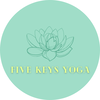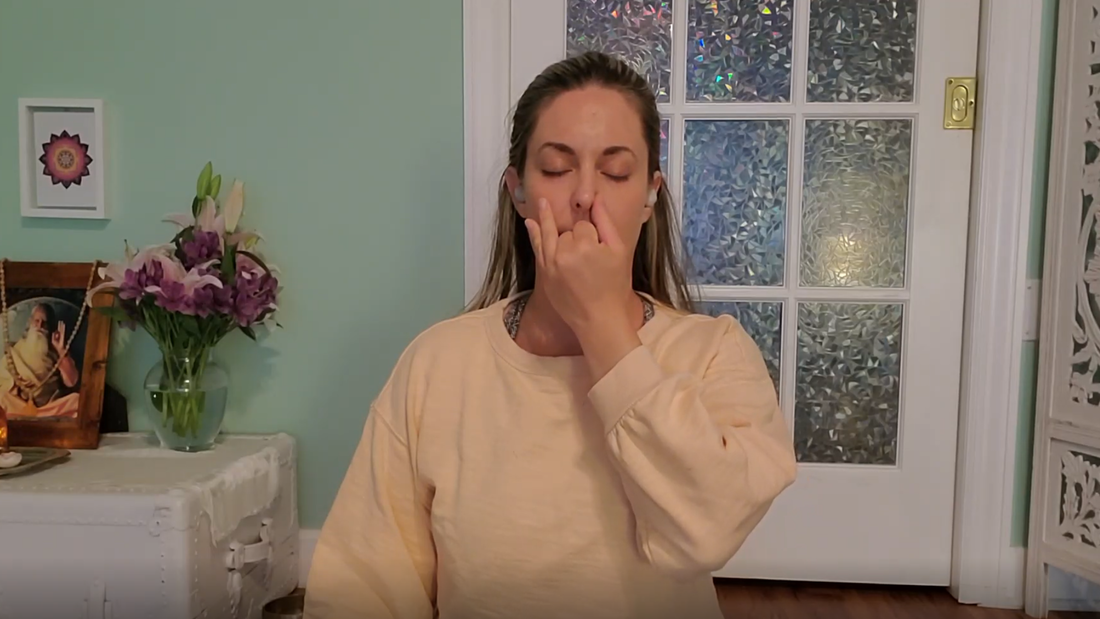|
We might call this post "How to Breathe Correctly". But pranayama is about much more than breathing.
Pranayama is a Sanskrit word made of two parts: "prana," which means vital energy and "yama," which means control. So pranayama means to control one's store of vital energy. This is accomplished through exercises involving the breath. Pranayama is the fourth limb of Raja or Ashtanga Yoga and is listed after Asana. Accordingly, pranayama is often taught as a next step after a beginner starts to understand how to practice yoga poses correctly. Pranayama both enhances our experience of asana, as it allows us to regulate our breathing to practice yoga poses more steadily and comfortably, and is the first step toward meditation, as it balances our energies and settles the mind. All breathing is practiced through the nose in yoga. However, if you feel claustrophobic or you're having trouble getting your breath, try breathing in through your nose and out through your mouth a few times and return to breathing through your nose, and then, the pranayama practice as you're ready. It may seem esoteric, but actually pranayama practices are very simple. The most important thing for the beginning practitioner is not to strain or overdo these practices, which is why it is usually recommended to practice these exercises under the guidance of an experienced teacher. There are also several breathing techniques that, while not formal pranayama practices, are very useful in teaching the beginner how to breathe comfortably and correctly before trying to practice pranayama in earnest. Practice all breathing and pranayama techniques for at least a few rounds and up to a few minutes each. I explore all these preparatory exercises and pranayama practices below with gifs. Because the breath is really subtle, you'll have to pay close attention to see what is happening in the gifs.
1 to 2 Breathing Ratio Technique
1 to 2 breathing is the simplest exercise and a great way to practice breathing correctly.
You can practice this sitting or lying down, though it may be nice to begin lying down, so you don't have to contend with the forces of gravity while you get the hang of it. First, make sure you are not breathing in a reversed pattern. Bring your breath into this format - as you breathe in, your belly expands, as you breathe out, your belly contracts. It may feel unnatural at first but keep working at it and eventually you will be able to control your breath in this way. That is step one. Second, once you've mastered this full breath, work on bringing your inhalation and exhalation into a 1 to 2 ratio. So for example, if you breathe in for four, breathe out for eight. If that feels like a strain, start with a 1 to 1 ratio (in for four, out for four) and gradually increase your exhalation until you can comfortably retain a 1 to 2 ratio with your breathing. The reason we focus on the exhalation in yoga is that it induces the vagus nerve to initiate the relaxation response through the parasympathetic nervous system.
4 - 2 - 8 Breathing Technique
This exercise is an expansion of the 1 to 2 breathing ratio and another exercise that is not a formal pranayama. Once you've mastered the 1 to 2 breath, you can start to find natural pauses between every inhalation to exhalation and every exhalation to inhalation.
You'll now be breathing in a 4 to 2 to 8 ratio. There is a very subtle distinction between this and the 1 to 2 breathing ratio. If you're not paying attention, this gif might look identical to the one above it. So for example, your breath might go like this - inhale for four, pause for two, exhale for eight, pause for two (then begin again with the next inhalation). As always, if at any point your breath becomes strained or you feel uncomfortable, resume your normal breathing and try again once you're ready.
Deerga Swasam Pranayama or Three Part Breath
Now we enter the world of bona fide pranayama. Deerga swasam or the three part breath is one of the gentlest pranayamas and is there are no contraindications for practicing it.
I am demonstrating it on the floor so that the movement is more visible but traditionally, it is practiced sitting up. Start with a complete exhalation. Next, breathe into your lungs one-third of the way, concentrating on filling the very bottom of your lungs so that the belly moves. Then, breathe another third of the way up, concentrating on the center of your lungs, so your chest moves. Finally, fill your lungs all the way to the top, so you feel your collarbones spread apart and rise slightly. Follow this with another complete exhalation, smoothly moving from the top all the way down to the bottom. If you are not used to breathing this deeply, you may cough. In that case, reduce the range of motion until you can practice this without coughing or return to the 4 -2 - 8 breath. Gradually, your lung capacity will increase and you'll be able to utilize more of your lungs as you practice deerga swasam.
Kapalabhati Pranayama or Skull-Shining Breath
This is the first pranayama that has an invigorating, rather than calming effect on the nervous system. It is contraindicated for heart disease, high blood pressure, vertigo, epilepsy, stroke, hernia or gastic ulcer. If you have one of these conditions, it is highly advisable to seek out instruction from an experienced teacher. It is also not recommended during pregnancy.
Kapal means skull and bhati means shining or illuminating. So kapalabhati pranayama can be translated to skull shining breath. In yoga traditions, it is thought that this practice stimulates the pituitary gland, which creates an illuminating effect and cleanses the respiratory system in preparation for other pranayama practices. It is practiced by snapping the abdominal wall backward to force the air out of the lungs through the nasal passages on the exhalation. The inhalation is a natural breath in, so that the focus on this exercise is on the exhalation. Notice in the gif how subtle the movement is. Most of the movement is concentrated in the belly. You don't need to practice too vigorously. The sensation should be like trying to gently blow something out of your nose. Always follow your kapalabhati practice by blowing your nose with a tissue to clean out the respiratory passages. Kapalabhati is also considered a kriya, or cleansing practice.
Bhastrika Pranayama or Bellows Breath
Bhastrika is translated as bellows, so this is the bellows breath. Once you practice it, you'll see why!
It is another invigorating pranayama and is contraindicated for stomach or intestinal ulcers, hernia, heart disease, high blood pressure, overactive thyroid gland or chronic diarrhea. If you have one of these conditions, it is highly advisable to seek out instruction from an experienced teacher. It is also recommended to not practice this on a full stomach. Bhastrika is practiced by gradually speeding up your natural breathing rhythm like a bellows. Now, the concentration is equally on the inhalation and exhalation. When practicing, it should never feel like a strain. So only go as fast as you can control. To end, slowly bring your breath back to normal. Again, this is a subtle practice and barely visible in the gif (which is why I have my hand placed on my belly - you don't need to do that). Although subtle, it revitalizes the nervous system and reduces residual air in the base of the lungs, which improves transfer of oxygen from the lungs to the bloodstream and carbon dioxide from the bloodstream into the lungs (where it is then expelled through the exhalation). This might prove to be an excellent exercise for those recovering from Covid, as it may improve blood oxygenation levels and is therefore known as a blood purifier.
Nadi Suddhi, Nadi Shodhana, Anulom Vilom
or Alternate Nostril Breath
This is my favorite pranayama and another very gentle, calming practice. There are no contraindications for practicing this simple variation. However, if you are stuffed up, I encourage you to practice kapalabhati or even use a neti pot first to make this pranayama more comfortable.
It has a number of names - Nadi Suddhi, Nadi Shodhana, or Anulom Vilom. In my tradition, it is called Nadi Suddhi, so that is what I will call it. Nadi are the invisible energy channels through which prana is conducted and suddhi means purification. So this exercise, purifies the nadis. The first thing to master is the hand postion, or mudra, used with nadi suddhi. Always use the right hand to practice mudras with nadi suddhi. I use vishnu mudra (index and middle finger to palm, all other fingers extended) but you can also use chin mudra (index finger and thumb touch, all other fingers are extended). To learn more, visit our blog post on mudras. Gently block your right nostril with your thumb and breathe in through the left nostril. Unblock your right nostril and block your left nostril with your fingers. Breathe out through the right nostril, then inhale through the right. Switch nostrils again and breathe out through the left nostril. This is one round. So the pattern of this pranayama is inhale, switch nostrils, exhale, inhale, switch nostrils, exhale; switching after every inhalation to exhale through the opposite nostril. This pranayama is thought to balance the sympathetic and parasympathetic sides of the autonomic nervous system. It produces a balancing effect on the body and acts as a tonic for the nervous system.
Pranayama is an incredible tool to add to your yoga practice and can be especially helpful as a bridge from practicing asana to developing a meditation practice, as it can help balance the mind.
However, it can be somewhat tricky to get the hang of without a teacher guiding you. If you're looking for a more in depth tutorial of how and why to practice pranayama, you can watch our free workshop, Breath Support for Changing Times.
2 Comments
Carol Aymar
11/3/2021 07:27:35 pm
Thank you for this breathing. I receive your emails and I always find them clear and helpful.
Reply
Leave a Reply. |
Archives
July 2024
About
Just some thoughts about yoga as I go... Categories
All
|
FIVE KEYS YOGA
|
WHAT OUR CLIENTS SAYFive Keys is fantastic! The studio is lovely and soothing, and the teachers are very caring and attentive. |
I've ... probably been to 25 different yoga studios. This is one of the most welcoming, calming spaces with very talented instructors. |
I love this yoga studio. It's a great balance of a good workout and relaxation and feels like a real community. |
An ideal studio for someone new to yoga. |


 RSS Feed
RSS Feed
